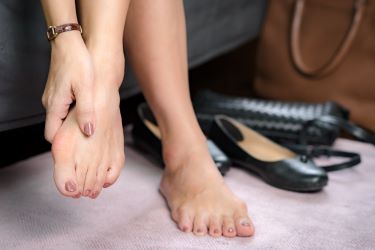.jpeg) The foot is a complex organic structure made of many different parts—and most of those parts are moving!
The foot is a complex organic structure made of many different parts—and most of those parts are moving!
With such intricacies, any imbalance or deviation from a standard foot structure can easily cause problems. Some of them become quite obvious—a pronounced bump on the side of the foot or bent toes, for example. Others, like fallen arches, are more internal, causing pain or discomfort without having as dramatic an outward appearance.
Third Coast Foot and Ankle provides supportive care for patients living with many types of foot deformities. From conservative treatments for managing symptoms to reconstructive surgery, we can guide you through a treatment plan and recommendations that best suit your individual needs and circumstances.
Common Types of Foot Deformities
While we are not limited to diagnosing and treating only the foot and toe deformities below, they rank among the most common that we see.
Bunions
Often described as “a bony bump” at the base of the big toe, a bunion is formed through an instability in the metatarsophalangeal (MTP) joint. This instability causes the toe to shift inward toward its neighbors and forces the MTP joint to stick out to the side. The bump can often become sore, inflamed, and irritated, and movement of the joint itself can become limited.
A similar situation can occur in the joint at the base of the smallest toe. This is commonly referred to as a “bunionette” or “tailor’s bunion.”
Hammer toes
The toes are normally held straight by a balance of muscles, tendons, and ligaments. When this balance is disrupted, the toes may remain in a bent position. In earlier stages, this bend remains rather flexible. Over time, however, it can become more difficult to flex the toe.
Hammer toes often become irritated as the top of the joint rubs against the inside of shoes, and moving the affected toes can also be painful.
Depending on which joint or joints are affected, the shape of the toe can change. “Mallet toes” and “claw toes” describe similar situations with different shapes.
Flat Feet
Sometimes also referred to as “fallen arches,” a flat foot indicates the lack of a substantial arch running along the underside of the foot. This often leaves a footprint that shows the entire sole of the foot instead of a “notch” along the inner side.
Flat feet can affect the way that weight and forces are distributed across the feet, as well as throughout the lower body. This can sometimes lead to pain in the arches, heels, ankles, knees, hips, or lower back.
High Arches
It isn’t just low arches that can cause problems—arches that are especially elevated can as well. Here, the arches are too pronounced, and a footprint may show a much larger “notch” along the inner side—even to the point where the middle of the foot doesn’t touch the ground at all.
High arches may lead to foot pain, especially against the ball and heel. These areas tend to receive greater stress due to this condition.
What Causes Foot Deformities?
In most cases, a hereditary factor lends itself to the development of foot and toe deformities. If bunions or flat feet run in your family, for example, the odds are greater that you may develop them, too.
However, other factors can also contribute to foot deformities, including past traumas and conditions such as arthritis. Being able to pinpoint the causes accurately can help steer the course of treatment.
Treating Foot and Toe Deformities
The primary goals of addressing conditions such as these are to:
- Manage pain and other symptoms in the best ways possible
- Limit or prevent progression of the condition
In the majority of cases, these goals can be met with the use of conservative treatments. In other words, surgery is not always the only resort one can take—even for conditions that have been present for years!
Once we know more about your condition, the causes behind it, and how your symptoms are affecting your life, we can recommend a treatment plan to address your needs. Parts of a plan might include one or more of the following:
- The use of custom orthotics to shift excess force away from trouble areas and properly redistribute weight across the feet
- Conditioning stretches and exercises to build strength, relieve pain, and maintain range of motion where needed
- The use of splints or braces to provide support or relieve pain as necessary
- Changes to footwear
- The use of pads and cushioning to protect common areas of irritation
If it is clear that more conservative methods will not have much effect, surgery might then be considered for lasting pain relief or to preserve mobility. Surgery is almost never performed only to improve the appearance of a deformity.
If surgery is a potential course of action, we will be sure to discuss all of what you should expect before, during, or after a procedure, as well as answer any questions you might have.
The Earlier You Begin Treatment, the Better!
Foot deformities in their earlier stages tend to be easier to influence and treat than those that have become more rigid. The sooner you see us for treatment, the more immediate results you may see. However, that does not mean a chronic deformity is hopeless. Call us to learn more!

